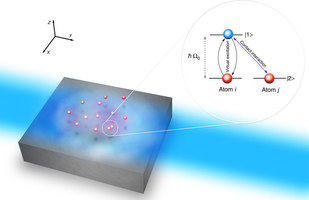July 03, 2013
In 1998, the Nobel Prize in Physics was conferred to the discovery of a new type of quantum fluid with fractional charge excitations, known as Laughlin state. The production of this quantum state, which explains the behaviour of electrons in two-dimensional metallic plaques when they are exposed to intense magnetic fields, has been one of the most popular research topics on ultracold and Bose-Einstein condensed atoms for one decade.
Now, a theoretical research developed by researchers from the University of Barcelona and the Institute of Photonic Sciences (ICFO) and published on Nature Communications proposes a method to generate this kind of states in two-dimensional systems of ultracold atoms, with possible applications in quantum computer.
The research combines several modern ideas such as the generation of artificial magnetic fields, which enable to study phenomena such as fractional quantum Hall states (which gives rise to Laughlin states) in systems composed by neutral atoms and the use of nanoplasmonic planar traps (a type of collective oscillations of the conduction electrons in a metal at quantum level) to confine the system in a two-dimensional region”, remarks Bruno Juliá, researcher from the University of Barcelona and first author of the paper.
According to numerical simulation, ultracold atoms would be suspended over a metallic surface by the action of a nanoplasmonic field. Once atoms are arranged like that, they would be lit by a laser that would enable to generate an artificial magnetic field that atoms would notice, as it happens with electrons on a metallic plaque. “It is an innovative research because we achieved to combine nanotechnology basics with ultracold atoms physics”, explains Maciej Lewenstein, researcher at ICFO.
To achieve interactions between atoms, which at first is prohibited by Pauli principle, the quantum mechanical principle that states that no two identical fermions may occupy the same quantum state simultaneously, and a similar behaviour to electrons’ charges repulsion, virtual excitation of each atom is used to produce an interatomic force and its intensity can be regulated in an experimental way.
The paper results from a collaboration among the Department of Structure and Constituents of Matter at the Faculty of Physics of the University of Barcelona and the groups on Theoretical Quantum-Nano Photonics and Quantum Optics Theory of the Institute of Photonic Sciences (ICFO).
B. Julia-Diaz, T. Grass, O. Dutta, D. E. Chang, M. Lewenstein. "Engineering p-wave interactions in ultracold atoms using nanoplasmonic“. Nature Communications, June 2013. DOI: 10.1038/ncomms3046















